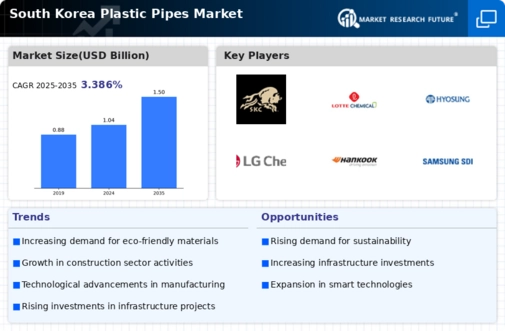Growth in Construction Activities
The construction sector in South Korea is experiencing robust growth, which is significantly impacting the plastic pipes market. With ongoing urban development and infrastructure projects, the demand for plastic pipes is on the rise. In 2025, the construction industry is anticipated to grow by 7%, leading to an increased requirement for plumbing and drainage systems that utilize plastic pipes. The plastic pipes market is benefiting from this trend, as these materials are lightweight, easy to install, and cost-effective. Furthermore, the versatility of plastic pipes makes them suitable for various applications, including residential, commercial, and industrial projects, thereby broadening their market appeal.
Increased Focus on Wastewater Management
The emphasis on effective wastewater management in South Korea is a key driver for the plastic pipes market. As urban areas expand, the need for efficient sewage and drainage systems becomes critical. The government is investing in wastewater treatment facilities, which often utilize plastic pipes due to their resistance to chemicals and ease of installation. In 2025, the market is projected to grow by 4% as municipalities prioritize upgrading their wastewater infrastructure. The plastic pipes market is thus positioned to play a vital role in these initiatives, providing solutions that enhance the efficiency and sustainability of wastewater management systems.
Rising Demand for Water Management Solutions
The increasing need for efficient water management solutions in South Korea is driving the plastic pipes market. With urbanization and population growth, the demand for reliable water supply systems has surged. The government has initiated various projects aimed at enhancing water infrastructure, which includes the installation of plastic pipes. In 2025, the market is projected to grow by approximately 8% as municipalities invest in modernizing their water distribution networks. This trend indicates a shift towards sustainable and durable materials, with plastic pipes being favored for their corrosion resistance and longevity. The plastic pipes market is thus positioned to benefit from these developments, as they provide essential solutions for water conservation and management.
Regulatory Support for Environmental Standards
In South Korea, stringent environmental regulations are shaping the plastic pipes market. The government has implemented policies that promote the use of eco-friendly materials in construction and infrastructure projects. This regulatory framework encourages the adoption of plastic pipes, which are often more sustainable compared to traditional materials. As of 2025, the market is expected to expand by 6% due to these supportive measures. The plastic pipes market is likely to see increased investments in research and development to create innovative products that comply with these regulations. This focus on sustainability not only aligns with global environmental goals but also enhances the competitiveness of local manufacturers.
Technological Innovations in Pipe Manufacturing
Technological advancements in the manufacturing processes of plastic pipes are revolutionizing the market in South Korea. Innovations such as improved extrusion techniques and the development of high-performance materials are enhancing the quality and durability of plastic pipes. These advancements are expected to drive the market growth by approximately 5% in 2025. The plastic pipes market is likely to benefit from these innovations, as they enable manufacturers to produce pipes that meet stringent performance standards. Additionally, the introduction of smart technologies in pipe systems is paving the way for more efficient monitoring and maintenance, further solidifying the role of plastic pipes in modern infrastructure.





















Leave a Comment